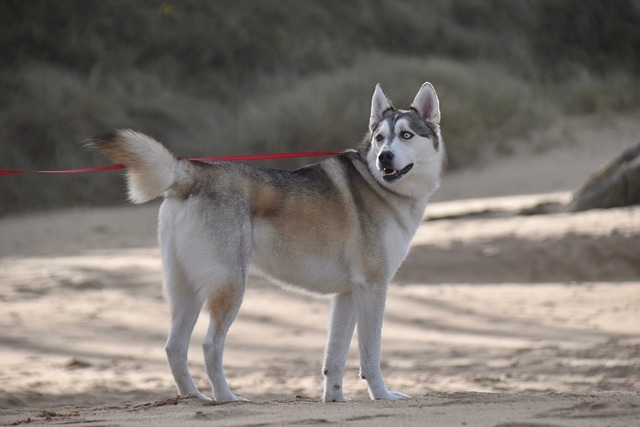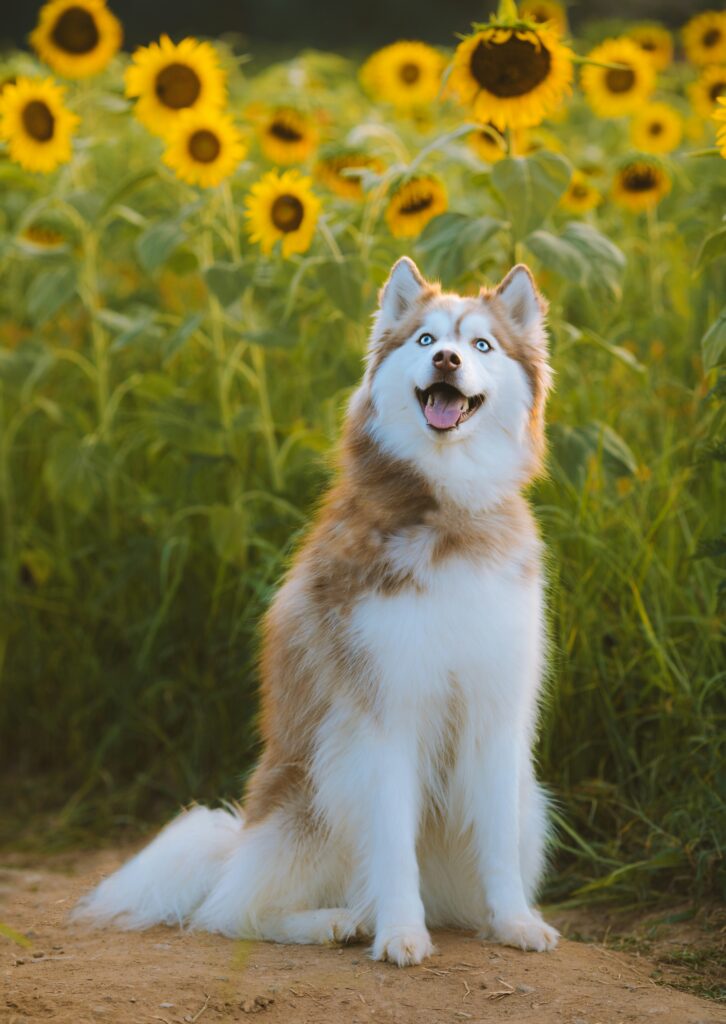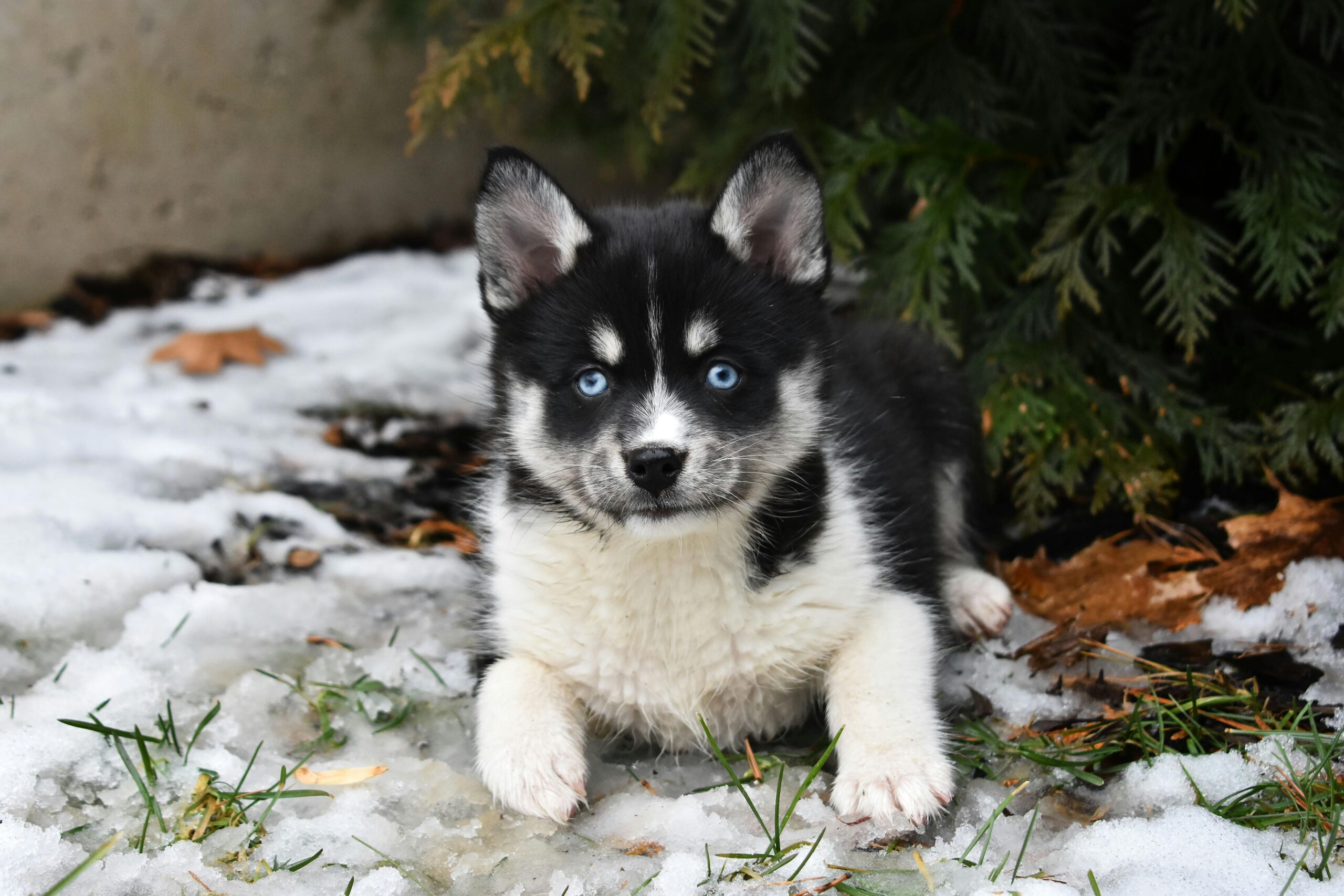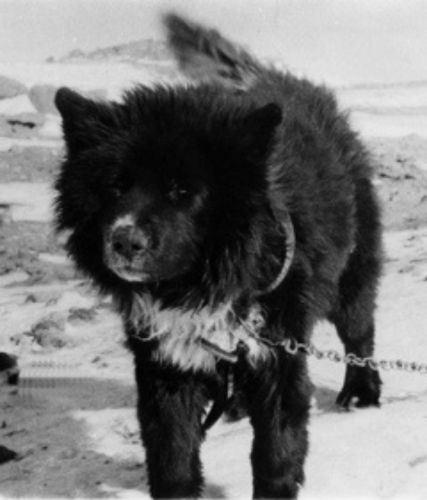Siberian Husky is known for its captivating eyes, friendly nature, and pulling abilities. This guide covers their personality, temperament, training, and health.
- Statistics
- Siberian Husky
- Adaptability
- Quick Facts
- Siberian Husky Temperament
- Siberian Husky Characteristics
- Siberian Husky Size
- Siberian Husky Personality
- Siberian Husky History
- Siberian Husky Training & Exercise
- Siberian Husky Nutrition
- Siberian Husky Care
- Siberian Husky Coat Color & Grooming
- Siberian Husk Health
- What to know before you buy or rehome a Siberian Husky
- FAQs
Statistics
| DOG BREED GROUP | Purebred Dogs |
| HEIGHT | 20 to 23 inches tall at the shoulder |
| WEIGHT | 35 to 60 pounds |
| LIFE SPAN | 12 to 15 years |
Siberian Husky
Originating from Siberia, Huskies are the most identified dog breed with their attractive look, blue & multicolor eyes, pointed ears, and bushy tail. Having a Husky dog in your home means you need to become smart compared to your Husky because these dogs are adventure-loving and always ready to explore the outside world. Furry Huskies are very active, friendly, over-smart, playful, and powerful. Husky is one of the oldest dog breeds in the world. Known for their stamina, intelligence, and pulling abilities, Huskies make a loyal and affectionate companions.
Husky dogs are popular because of their wolf-like appearance, striking eyes, and willpower. This independent breed needs extra training, grooming, and care, especially if you are a first-time husky owner. You can control boredom and unhealthy behaviors such as digging or chewing with proper training and care. Before taking Huskies to your home, make sure the area or yard properly fenced up to the ground so that no escapes left because Huskies can creep under the fence. Make the fence escape-proof.
Siberian Husky is an energetic and beautiful dog breed that is social and loves the people’s attraction. If you want an adventure-loving dog that explores the world with you, Husky can be the best dog for you.
Adaptability
Huskies are famous for their exceptional adaptability of surviving in the harsh conditions of Siberia. Bred originally by the Chukchi people, these resilient dogs have developed a unique set of characteristics that enable them to thrive in extreme cold, thanks to their thick double coat which provides insulation against freezing temperatures.
However, their adaptability extends beyond cold climates. Huskies are also capable of adjusting to warmer environments, provided they have adequate shelter, hydration, and opportunities to cool down. Their high energy levels and endurance make them versatile companions for various activities, from sledding in the snow to hiking in milder climates.
Social and intelligent, huskies also adapt well to family life, requiring mental stimulation and physical exercise to stay healthy and content. Their ability to thrive in diverse conditions underscores their remarkable versatility and enduring appeal as a breed.
Quick Facts
- Origin: Siberia, Russia
- Lifespan: 12-15 years
- Coat: Thick double coat suitable for cold weather and vary in combinations of black, white, gray, red, and more
- Temperament: Huskies are friendly, intelligent, and out going dog usually go well with other pets and people
- Exercise Needs: These dogs are active in various activities such as hiking, running, and pulling sleds, therefore require plenty of exercise for mental stimulation.
- Training: Because of their independent nature, early socialization and training is crucial
- Grooming: Due to their high shedding coats regular brushing is essential particularly during shedding seasons
- Health: Siberian Huskies are generally a healthy breed, but they can be prone to certain conditions like hip dysplasia and eye issues. Proper diet and exercise are essential for their overall health.
Siberian Husky Temperament
Huskies are known for their friendly and outgoing temperament, making them excellent companions for active individuals or families. They possess a high energy level and playful nature, often displaying a sense of mischief and curiosity. Huskies are generally friendly both with people and another dog. This breed thrives on physical activity and mental stimulation, requiring regular exercise and engaging activities to prevent boredom. Despite their independent nature, huskies are loyal and affectionate with their families, forming strong bonds and enjoying companionship.
Siberian Husky Characteristics
Particularly Husky dogs aren’t barking dogs but these dogs use other form of vocal sounds such as howling, grunting, and woo-woos to express themselves. Dogs are individuals, and not all dogs, even those of the same breed, will exhibits the same qualities.
| Friendliness | High |
| Exercise Needs | High |
| Health Issues | Medium |
| Barking Tendencies | Medium |
| Grooming Needs | High |
| Shedding Level | High |
| Training Needs | Medium |
| Energy Level | High |
| Playfulness | High |

Siberian Husky Size
Siberian Huskies are medium-size dogs, 20 to 24 inches tall and 35 to 60 pounds in weight. Males are typically larger than females.
Siberian Husky Personality
Siberian Huskies are typically very friendly and social dogs. They enjoy being around people and other dogs, making them excellent companions for families and individuals alike. Huskies are high-energy dogs that require plenty of exercise and mental stimulation. They are playful and thrive in environments where they can run, play, and explore. Regular physical activity is essential to prevent boredom, which can lead to destructive behavior.
These dogs are highly intelligent and can be quite independent. While this intelligence makes them quick learners, it also means they can be somewhat stubborn. Siberian Huskies have a curious nature and can be quite mischievous. They are popular for their tendency to explore and sometimes escape from yards or enclosures.
Huskies are known for their vocalizations, often “talking” or howling rather than barking. They use a range of sounds to express themselves, from howls and whines to a unique chattering noise. This vocal behavior is part of their charm but can be surprising to those unfamiliar with the breed.
While Huskies are affectionate and enjoy spending time with their human families, they are not typically clingy. They can be quite content being near their owners without needing constant attention, making them a good choice for people who want a loving but independent pet.
Given their history as sled dogs, Siberian Huskies have a strong pack mentality. They generally do well with other dogs and enjoy being part of a group. Proper socialization from a young age is important to help them get along with other pets and people.
Siberian Husky History
Huskies have a storied history deeply intertwined with the Arctic and sub-Arctic regions. Originating from Siberia, the Siberian Husky was developed by the Chukchi people as a sled dog capable of traversing vast, frozen landscapes. Their compact and efficient build, combined with a thick double coat, allowed them to endure harsh climates while maintaining speed and agility.
In the early 20th century, huskies gained international fame when they were imported to Alaska for sled dog races, notably the All-Alaska Sweepstakes. Their resilience and reliability were further showcased during the 1925 serum run to Nome, where a relay of huskies helped deliver diphtheria antitoxin to the isolated town, preventing an epidemic. Today, huskies are celebrated not only as working dogs but also as beloved companions, admired for their friendly nature and spirited energy.
Siberian Husky Training & Exercise
Training and exercising a Husky is crucial for their well-being. To keep them physically fit and mentally stimulated, it’s essential to engage them in regular, vigorous exercise. This can include long walks, runs, or hikes. Activities such as agility training, fetch, and even dog sports like skijoring can also be highly beneficial.
In addition to physical exercise, mental stimulation is equally important for Huskies. These dogs thrive on challenges that engage their sharp minds. Training sessions should include obedience training, trick training, and puzzle toys that require problem-solving. Consistent training helps in establishing boundaries and commands, which is particularly important for the Husky’s independent and sometimes stubborn nature. Positive reinforcement methods, such as treats and praise, work best with this breed, encouraging them to repeat desired behaviors.
Socialization is another critical aspect of a Husky’s training regime. Exposing them to various environments, people, and other animals from a young age helps in developing a well-rounded temperament. Puppy classes, playdates, and regular visits to dog parks are excellent ways to ensure they become confident and sociable adults. A well-socialized Husky is less likely to exhibit anxiety or aggression and is more adaptable to new situations.
Given their high prey drive and potential for escape, secure environments are a must when training and exercising Huskies. Using a leash during walks and outdoor activities in unfenced areas is also crucial to ensure their safety and prevent them from running off in pursuit of small animals.

Siberian Husky Nutrition
Husky nutrition requires a balanced diet rich in protein, healthy fats, and essential vitamins and minerals to support their high energy levels and active lifestyle. As working dogs, Huskies need a diet that includes high-quality animal proteins, such as chicken, beef, or fish, to maintain muscle mass and overall health. Incorporating omega-3 and omega-6 fatty acids is crucial for their coat health and joint function. Additionally, a moderate amount of carbohydrates from sources like sweet potatoes or brown rice can provide sustained energy. It’s essential to avoid fillers and artificial additives, as Huskies can be prone to food sensitivities. Regular monitoring and adjustments based on the dog’s activity level, age, and health status ensure optimal nutrition and well-being.
Siberian Husky Care
Taking care of a Husky involves understanding their unique needs and characteristics, given their origins as working dogs in cold climates. One of the key aspects of Husky care is ensuring they receive ample exercise. These dogs need vigorous physical activity daily, ideally including activities like running, hiking, or participating in dog sports. Without sufficient exercise, Huskies can become bored and may develop destructive behaviors.
Nutrition is another critical component of Husky care. A balanced diet that meets their high-energy needs is essential. It’s important to choose high-quality dog food, either commercial or home-prepared, with guidance from a veterinarian to ensure all nutritional requirements are met. Huskies can be prone to digestive sensitivities, so monitoring their diet and adjusting as necessary is vital.
Training and socialization are also paramount for a well-adjusted Husky. Due to their intelligence and stubborn streak, consistent, positive reinforcement training techniques work best. Early socialization helps Huskies develop good manners and reduces potential behavioral issues. Socialization should include exposure to various people, environments, and other animals. Given their strong prey drive, it’s essential to supervise interactions with smaller pets and practice reliable recall commands.
Healthcare is an ongoing commitment for Husky owners. Regular veterinary check-ups, vaccinations, and preventive care for parasites are necessary to keep them healthy. Owners should also be prepared for the extra care required during hot weather, as Huskies are more comfortable in cooler temperatures. Ensuring they have access to shade, fresh water, and cool resting spots helps prevent overheating.
Siberian Husky Coat Color & Grooming
Husky grooming is an essential aspect of maintaining the health and appearance of these beautiful and energetic dogs. Known for their thick double coats, Huskies require regular grooming to keep their fur in optimal condition and to minimize shedding. The double coat consists of a soft, dense undercoat that provides insulation and a longer, coarser topcoat that offers protection from the elements. Regular brushing, ideally a few times a week, is crucial to remove loose hair, prevent matting, and distribute natural oils that keep the coat shiny and healthy.
Bathing a Husky should be done sparingly, about once every few months, unless they get particularly dirty. Over-bathing can strip their coat of natural oils, leading to dryness and irritation. When bathing is necessary, it’s important to use a gentle dog shampoo designed for double-coated breeds. After the bath, thorough drying is important to prevent moisture from getting trapped in the undercoat, which can lead to skin issues.
In addition to coat care, Husky grooming also involves attention to their ears, nails, and teeth. Regularly check their ears for signs of infection or wax buildup and cleaned gently with a vet-approved ear cleaner. Nails should be trimmed regularly to prevent overgrowth and splitting, which can be painful and lead to more serious issues. Dental hygiene is equally important; regular brushing of their teeth and providing dental chews can help prevent tartar buildup and maintain overall oral health.
Siberian Husk Health
Siberian Huskies, renowned for their striking appearance and remarkable endurance, require attentive care to maintain their well-being. While they are generally robust dogs, they are susceptible to several health issues that owners should be aware of.
Seizures and Epilepsy: Epilepsy, a neurological disorder characterized by recurrent seizures, can occur in Siberian Huskies. While the exact cause is often unknown, genetics may play a significant role. Seizures can vary in severity and frequency, and management typically involves antiepileptic medications prescribed by a veterinarian. Monitoring for triggers and maintaining a stable environment can also help reduce the frequency of seizures.
Back Spine and Neck Issues: Siberian Huskies are prone to back spine and neck problems, particularly intervertebral disc disease (IVDD). This condition involves the degeneration or herniation of spinal discs, leading to pain, weakness, and sometimes paralysis. Activities that put strain on the spine, such as jumping or rough play, should be minimized.
Tumors and Growths: Like many breeds, Siberian Huskies are susceptible to various tumors and growths, both benign and malignant. Regular grooming sessions provide an opportunity to inspect the skin for any unusual lumps, bumps, or changes in texture or color. Early detection of tumors allows for prompt veterinary evaluation and treatment, which may include surgical removal, chemotherapy, or other interventions depending on the nature and extent of the growth.
Cruciate Ligament Disease: Cruciate ligament injuries, particularly to the cranial cruciate ligament (equivalent to the human ACL), are common in Siberian Huskies. These injuries often result from sudden twisting motions or repetitive stress on the knee joint. Symptoms include lameness, swelling, and difficulty bearing weight on the affected leg. Treatment may involve surgical repair followed by rehabilitation to restore mobility and strength.
What to know before you buy or rehome a Siberian Husky
Before committing to buying or rehoming a Husky, it’s crucial to understand their unique needs and characteristics. Firstly, Huskies are incredibly energetic and require plenty of exercise and mental stimulation to prevent boredom and destructive behaviors. They thrive in environments where they can run and play freely, so access to a secure outdoor space is essential.
Additionally, Huskies have a strong prey drive and may not get along well with small animals like cats or small dogs unless properly socialized from a young age. Their thick double coat requires regular grooming to prevent matting and keep shedding under control. Furthermore, Huskies are known for their independent nature, which can make training a challenge without patience, consistency, and positive reinforcement techniques.
Lastly, Huskies are social animals and can suffer from separation anxiety if left alone for extended periods, so they do best in homes where someone is present for much of the day or with the company of another dog. Understanding and being prepared for these aspects of Husky ownership is essential for providing them with a happy and fulfilling life.
FAQs
Do Huskies shed?
Yes, Huskies are known for shedding heavily, especially during seasonal changes. They have a thick double coat that helps them regulate their body temperature in cold climates, but it also means they shed a lot of fur.
Are Huskies dangerous?
Huskies are not inherently dangerous, but like all dogs, their behavior can be influenced by factors such as training, socialization, and individual temperament. They are generally friendly and social dogs when properly trained and cared for.
Are Huskies good family dogs?
Huskies can make great family dogs under the right circumstances. They are known for their loyalty, affection, and playful nature, which can make them wonderful companions for families with children.



